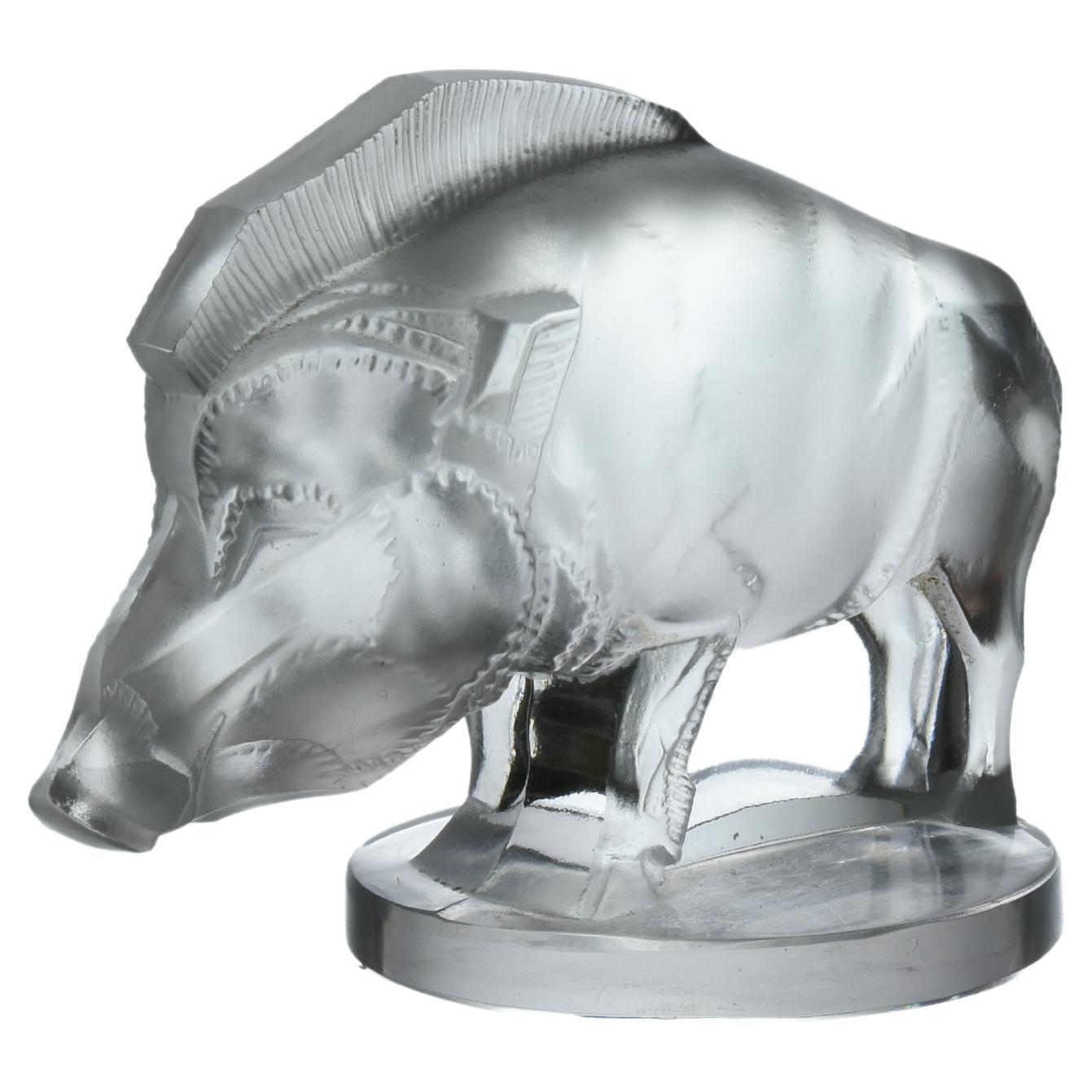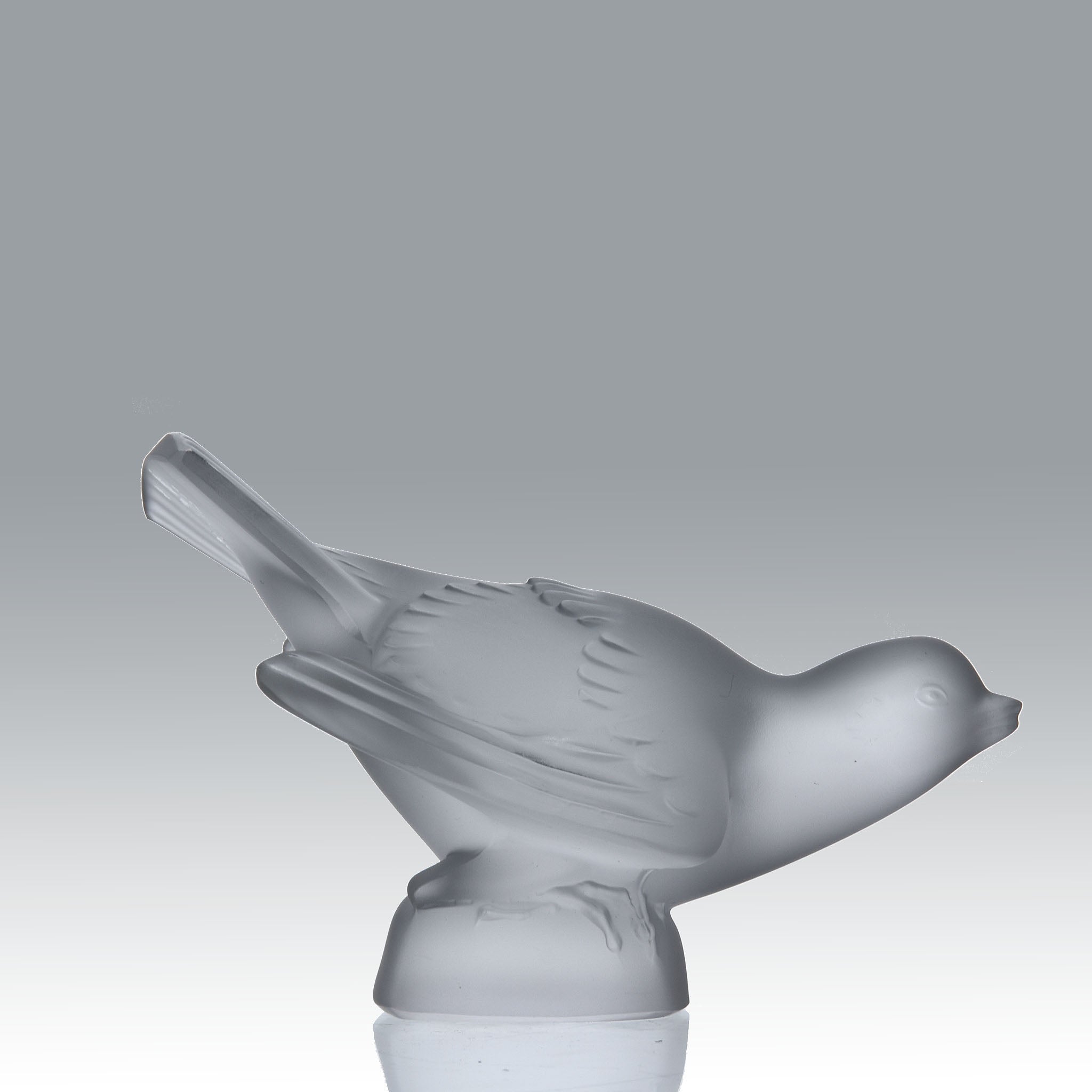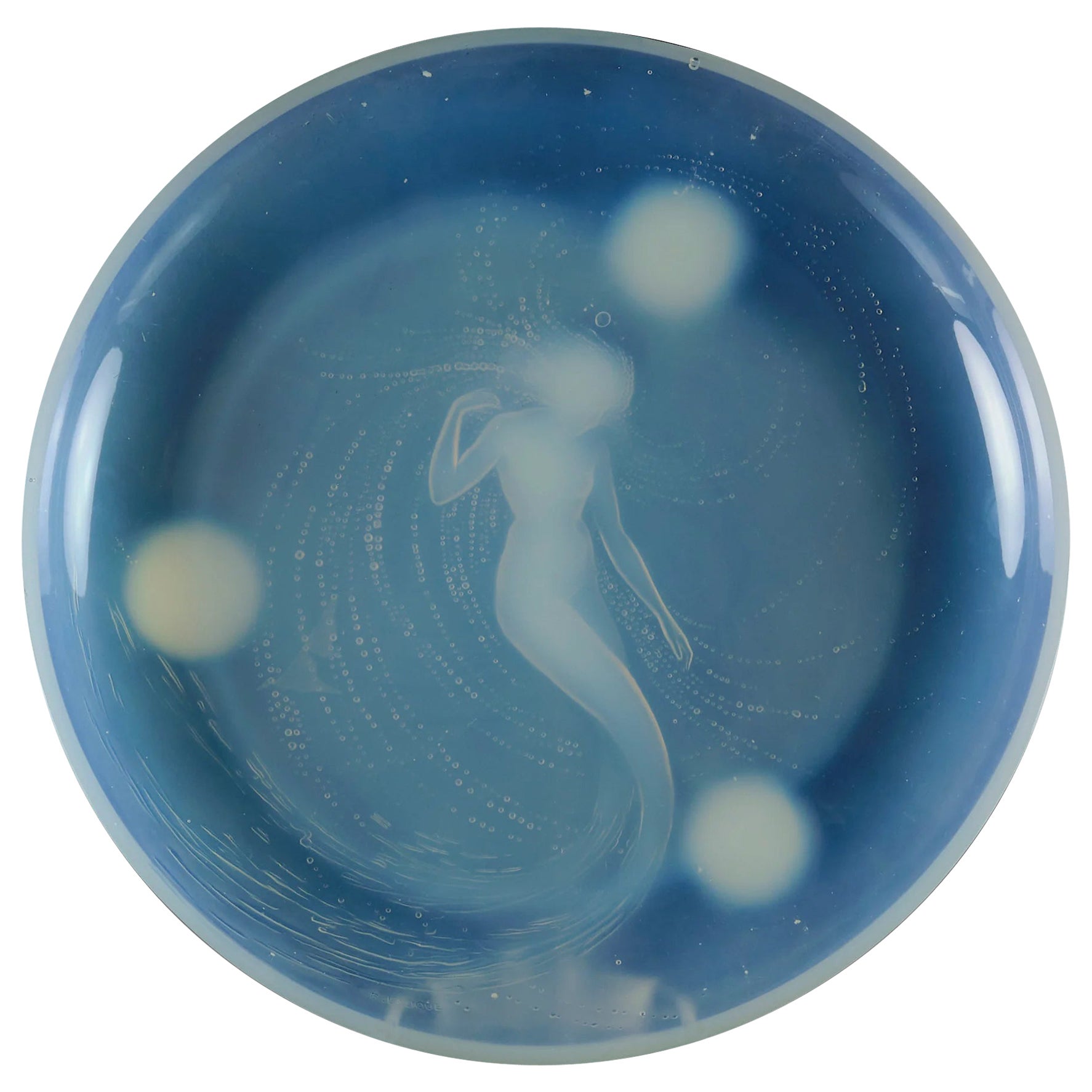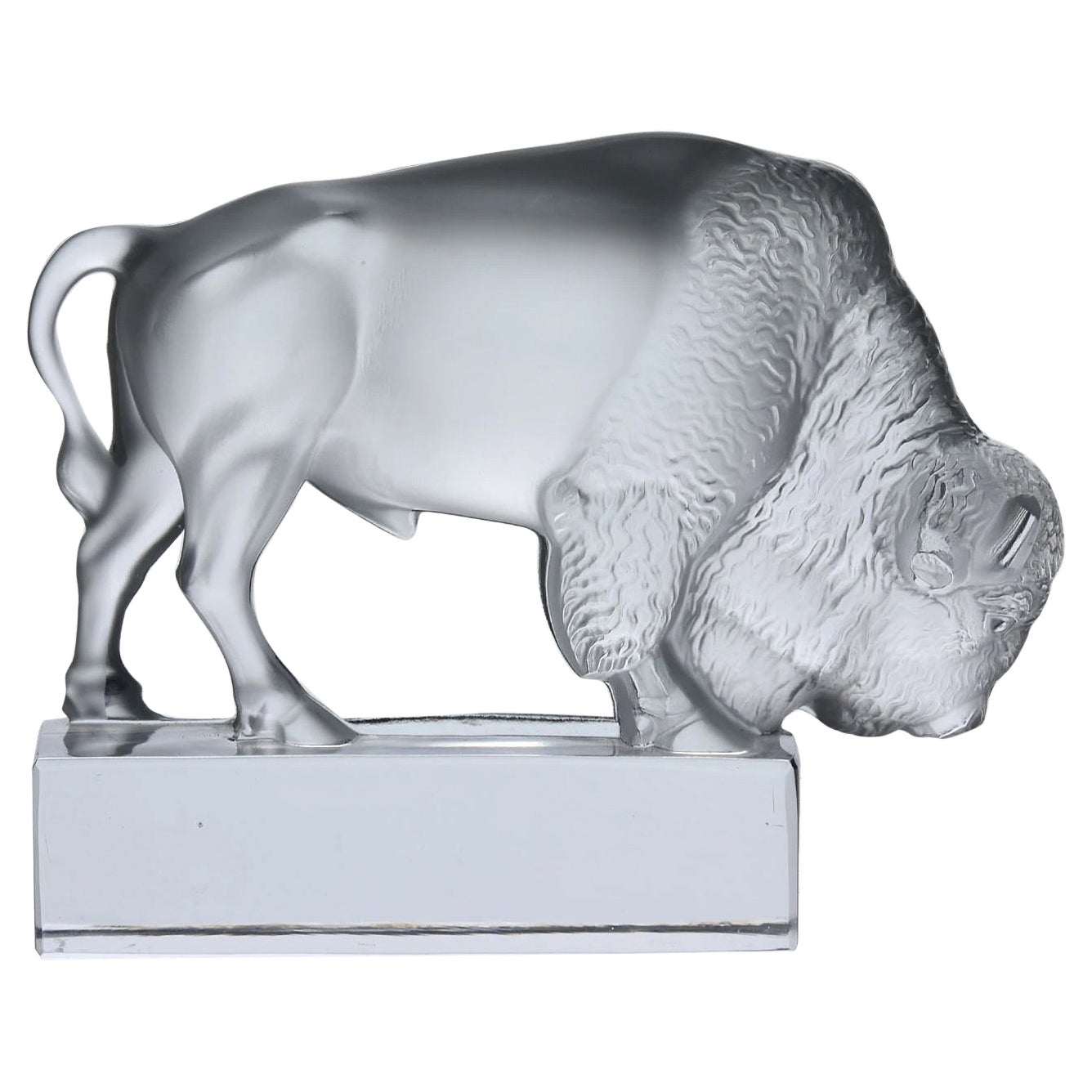Early 20th Century Glass Sculpture entitled "Moineau Sournois" by Rene Lalique
About the Item
- Creator:René Lalique (Artist)
- Dimensions:Height: 2.17 in (5.5 cm)Width: 4.34 in (11 cm)Depth: 1.38 in (3.5 cm)
- Style:Art Deco (Of the Period)
- Materials and Techniques:
- Place of Origin:
- Period:
- Date of Manufacture:1930
- Condition:Wear consistent with age and use.
- Seller Location:London, GB
- Reference Number:
René Lalique
The career of the famed jewelry designer, glassmaker and decorative artist René Lalique spanned decades and artistic styles. Best known today for his works in glass, Lalique first won recognition for his jewelry. He was described as the inventor of modern jewelry by the French artist and designer Émile Gallé, and his luxurious naturalistic designs helped define the Art Nouveau movement. Later as a glassmaker in the 1920s and ‘30s, Lalique designed vases, clocks, chandeliers and even car hood ornaments that were the essence of Art Deco chic. Even now, the name Lalique continues to be a byword for a graceful, gracious and distinctively French brand of sophistication.
Born in 1860 in the Marne region of France, Lalique began his career as a jewelry designer in the last decades of the 19th century. His work employed now-classic Art Nouveau themes and motifs: flowing, organic lines; forms based on animals, insects and flowers — all rendered in luxurious materials such as ivory, enamel, gold and semi-precious stones. By 1905, Lalique had begun creating works in glass, and his style began to shift to a cleaner, sharper, smoother, more modern approach suited to his new medium. His Paris shop’s proximity to perfumer François Coty’s led him to experiment with beautiful perfume bottles. He offered the first customized scent bottles, transforming the perfume industry. By the end of the First World War, the artist had fully embraced Art Deco modernity, devoting himself to new industrial techniques of glass production and designs that manifest the sweeping lines and the forms suggestive of speed and movement characteristic of the style. Lalique’s work looked both backward and forward in time: embracing ancient mythological themes even as it celebrated modern progress.
Late in his career, Lalique took on high profile luxury interior design projects in Paris, Tokyo and elsewhere. He designed decorative fixtures and lighting for the interior of the luxury liner Normandie in 1935, and decorated the salons of well-known fashion designer Madeleine Vionnet. Today, Lalique’s influence is as relevant as it was when he opened his first jewelry shop in 1890. In a modern or even a traditional décor, as you will see from the objects offered on these pages, the work of René Lalique provides the stamp of savoir-faire.
- ShippingRetrieving quote...Ships From: London, United Kingdom
- Return PolicyA return for this item may be initiated within 10 days of delivery.
- Early-20th Century Clear Glass Car Mascot Entitled "Sanglier" by René LaliqueBy René LaliqueLocated in London, GBExcellent Art Deco car mascot in the form of a stylised boar with very fine hand chased surface detail, signed R. Lalique France Sanglier Catalogue Number: 1157 Signature identifica...Category
Vintage 1920s French Art Deco Figurative Sculptures
MaterialsGlass
- Early 20th Century Art Deco Glass Mascot entitled "Faucon" by René LaliqueBy René LaliqueLocated in London, GB"Faucon" by René Lalique Dramatic early 20th Century French Art Deco clear glass car mascot modelled as a standing falcon with good hand finished detail, signed R Lalique and France...Category
Early 20th Century French Art Deco Animal Sculptures
MaterialsGlass
- Mid-20th Century Frosted Glass Study entitled "Moineau Colereux" by Marc LaliqueBy Marc LaliqueLocated in London, GBA very sweet clear and frosted glass study of a soaring sparrow, its head and tail raised, the surface with excellent hand finished detail, signed Lalique France ADDITIONAL INFORMATION Height: 8.5 cm Width: 13 cm Condition: Excellent Condition Circa: 1960 Materials: Frosted Glass ABOUT Lalique Glass René Lalique (1860-1945) began his career as a jewellery apprentice at the age of 16, and by 1881 he was a freelance designer for many of the best-known Parisian jewellers. In 1885, he opened his own workshop on Place Gaillon in Paris, the former workshop of Jules Destape. In 1887, Lalique opened a business on Rue du Quatre-Septembre, and registered the "RL" mark the following year. In 1890, he opened a shop in the Opera District of Paris. Within a decade, Lalique was amongst the best-known Parisian jewellers. In 1905, Lalique opened a new shop at Place Vendôme which exhibited not only jewellery, but glass works as well. It was close to the shop of renowned perfumer François Coty; in 1907, Lalique began producing ornate perfume bottles for Coty. The production of glass objects began at his country villa in 1902, and continued there until at least 1912. The first Lalique glassworks opened in 1909 in a rented facility in Combs-la-Ville, which Lalique later purchased in 1913. In December 1912, Lalique hosted an exhibition of Lalique Glass—as his glass would come to be known—at the Place Vendôme shop. During the First World War, the glassworks produced mundane items in support of the war effort. In 1919, work began on a new production facility in Wingen-sur-Moder, which opened in 1921. From 1925-1931, Lalique produced 29 models of hood ornaments; a mermaid statuette first produced in 1920 was also later sold as a hood ornament. During the 1920s and 1930s, Lalique was amongst the world's most renowned glassmakers. René Lalique died in 1945. His son Marc Lalique took over the business, operating initially as "M.Lalique" and later as "Cristal Lalique...Category
Mid-20th Century French Art Deco Animal Sculptures
MaterialsGlass
- Early 20th Century Opalescent Salver Entitled “Sirène” by René LaliqueBy René LaliqueLocated in London, GBAn exceptional frosted glass salver with raised deep opalescent design of a beautiful mermaid in a swirling watery landscape, the three large bubbles around her protruding from the underside to act as feet, signed R Lalique Sirène Catalogue Number: 376 Signature Identification: “R. Lalique France” moulded in relief Date Introduced: 1920 Dimensions: 36 cm Diameter Felix Marcilhac Catalogue Raisonné Page 290 Additional information: Diameter: 36 cm Condition: Excellent Original Condition circa: 1920 Materials: Frosted and Opalescent Glass Book Ref: R.Lalique – Catalogue Raisonné by Felix Marcilhac About: 1860 Birth of René Lalique René Lalique was born in Aÿ-en-Champagne in the Marne region of France. Some years later, the Lalique family moved to Paris but continued to spend holidays in Aÿ. René remained deeply attached to his birthplace throughout his life. 1885 The first Parisian workshop Following the death of his father, René became an apprentice to craftsman and jeweller Louis...Category
Early 20th Century French Art Deco Garniture
MaterialsGlass
- 20th Century Frosted Glass Sculpture Entitled "Standing Elephant" by LaliqueBy Marc LaliqueLocated in London, GBImpressive Mid-20th Century clear and frosted glass figural study of an African elephant with its trunk raised. The surface with fine detail, signed Lalique France Additional information Height: 15 cm Condition: Excellent Condition circa: 1970 Materials: Clear & Frosted Glass About Lalique Glass René Lalique (1860-1945) began his career as a jewellery apprentice at the age of 16, and by 1881 he was a freelance designer for many of the best-known Parisian jewellers. In 1885, he opened his own workshop on Place Gaillon in Paris, the former workshop of Jules Destape. In 1887, Lalique opened a business on Rue du Quatre-Septembre, and registered the "RL" mark the following year. In 1890, he opened a shop in the Opera District of Paris. Within a decade, Lalique was amongst the best-known Parisian jewellers. In 1905, Lalique opened a new shop at Place Vendôme which exhibited not only jewellery, but glass works as well. It was close to the shop of renowned perfumer François Coty; in 1907, Lalique began producing ornate perfume bottles for Coty. The production of glass objects began at his country villa in 1902, and continued there until at least 1912. The first Lalique glassworks opened in 1909 in a rented facility in Combs-la-Ville, which Lalique later purchased in 1913. In December 1912, Lalique hosted an exhibition of Lalique Glass—as his glass would come to be known—at the Place Vendôme shop. During the First World War, the glassworks produced mundane items in support of the war effort. In 1919, work began on a new production facility in Wingen-sur-Moder, which opened in 1921. From 1925-1931, Lalique produced 29 models of hood ornaments; a mermaid statuette first produced in 1920 was also later sold as a hood ornament. During the 1920s and 1930s, Lalique was amongst the world's most renowned glassmakers. René Lalique died in 1945. His son Marc Lalique took over the business, operating initially as "M.Lalique" and later as "Cristal Lalique...Category
20th Century French Art Deco Animal Sculptures
MaterialsGlass
- 20th Century Clear Glass Sculpture Entitled "Bison Paperweight" by Lalique GlassBy LaliqueLocated in London, GBAn impressive clear and frosted glass paperweight in the form of a grazing bison with excellent hand finished detail, signed Lalique France ADDITIONAL INFORMATION Height: 9.5 cm Width: 12 cm Condition: Excellent Condition circa: 1970 Materials: Frosted Glass ABOUT Lalique Glass René Lalique (1860-1945) began his career as a jewellery apprentice at the age of 16, and by 1881 he was a freelance designer for many of the best-known Parisian jewellers. In 1885, he opened his own workshop on Place Gaillon in Paris, the former workshop of Jules Destape. In 1887, Lalique opened a business on Rue du Quatre-Septembre, and registered the "RL" mark the following year. In 1890, he opened a shop in the Opera District of Paris. Within a decade, Lalique was amongst the best-known Parisian jewellers. In 1905, Lalique opened a new shop at Place Vendôme which exhibited not only jewellery, but glass works as well. It was close to the shop of renowned perfumer François Coty; in 1907, Lalique began producing ornate perfume bottles for Coty. The production of glass objects began at his country villa in 1902, and continued there until at least 1912. The first Lalique glassworks opened in 1909 in a rented facility in Combs-la-Ville, which Lalique later purchased in 1913. In December 1912, Lalique hosted an exhibition of Lalique Glass—as his glass would come to be known—at the Place Vendôme shop. During the First World War, the glassworks produced mundane items in support of the war effort. In 1919, work began on a new production facility in Wingen-sur-Moder, which opened in 1921. From 1925-1931, Lalique produced 29 models of hood ornaments; a mermaid statuette first produced in 1920 was also later sold as a hood ornament. During the 1920s and 1930s, Lalique was amongst the world's most renowned glassmakers. René Lalique died in 1945. His son Marc Lalique took over the business, operating initially as "M.Lalique" and later as "Cristal Lalique...Category
Late 20th Century French Art Deco Animal Sculptures
MaterialsGlass
- 1925 René Lalique Seal Stamp Moineau Sparrow Clear GlassBy René LaliqueLocated in Boulogne Billancourt, FRSeal Stamp "Moineau" (Sparrow) made in clear glass by René Lalique in 1925. Stamped signature. Perfect condition height: 5 cm Félix Marcilhac, René Lalique - Catalogue Raisonné de...Category
Vintage 1920s French Art Deco Animal Sculptures
MaterialsGlass, Art Glass
- René Lalique '1860-1945' "Moineau" Cendrier Marcilhac NO. 284By René LaliqueLocated in West Palm Beach, FLRené Lalique (1860-1945) "Moineau" Cendrier Marcilhac NO. 284 Script signature R. LALIQUE molded mint green glass with an opalescent lip model in...Category
20th Century Animal Sculptures
MaterialsGlass
- Rene Lalique Opalescent Glass 'Naiade' StatuetteBy René LaliqueLocated in Chelmsford, EssexRene lalique opalescent glass 'naiade' statuette. Grey stained details. Features a naiad crouching, holding a shell(?) up to her ear. In Greek mythology, the naiads are a type of fem...Category
Vintage 1920s French Art Deco Figurative Sculptures
MaterialsGlass
- René Lalique 'Nemours', '1929', 20th CenturyBy René LaliqueLocated in Madrid, ESRene Lalique Cup 'Nemours' (1929). In French glass of the 20th century, molded and relined. Sign 'Lalique, France'. This model was produced in the years 1940 to 1959. Only us...Category
20th Century French Modern More Desk Accessories
MaterialsCrystal
- A Rene lalique Ram Glass Art Deco MascotBy René LaliqueLocated in SAINT-OUEN-SUR-SEINE, FRThe R.Lalique's car mascots are famous. There quality is outstanding as well as for the glass as for the sharpness of the mould . This mascot was created in 1928, one of his first a...Category
Vintage 1920s French Art Deco Animal Sculptures
MaterialsGlass
- René Lalique, France, Nude Woman in Frosted Art Glass, Mid-20th CenturyLocated in Copenhagen, DKRené Lalique, France. Nude woman in frosted art glass. Mid-20th century. Measures: 8.5 x 8 cm. In excellent condition. Signed.Category
Mid-20th Century French Figurative Sculptures
MaterialsArt Glass





